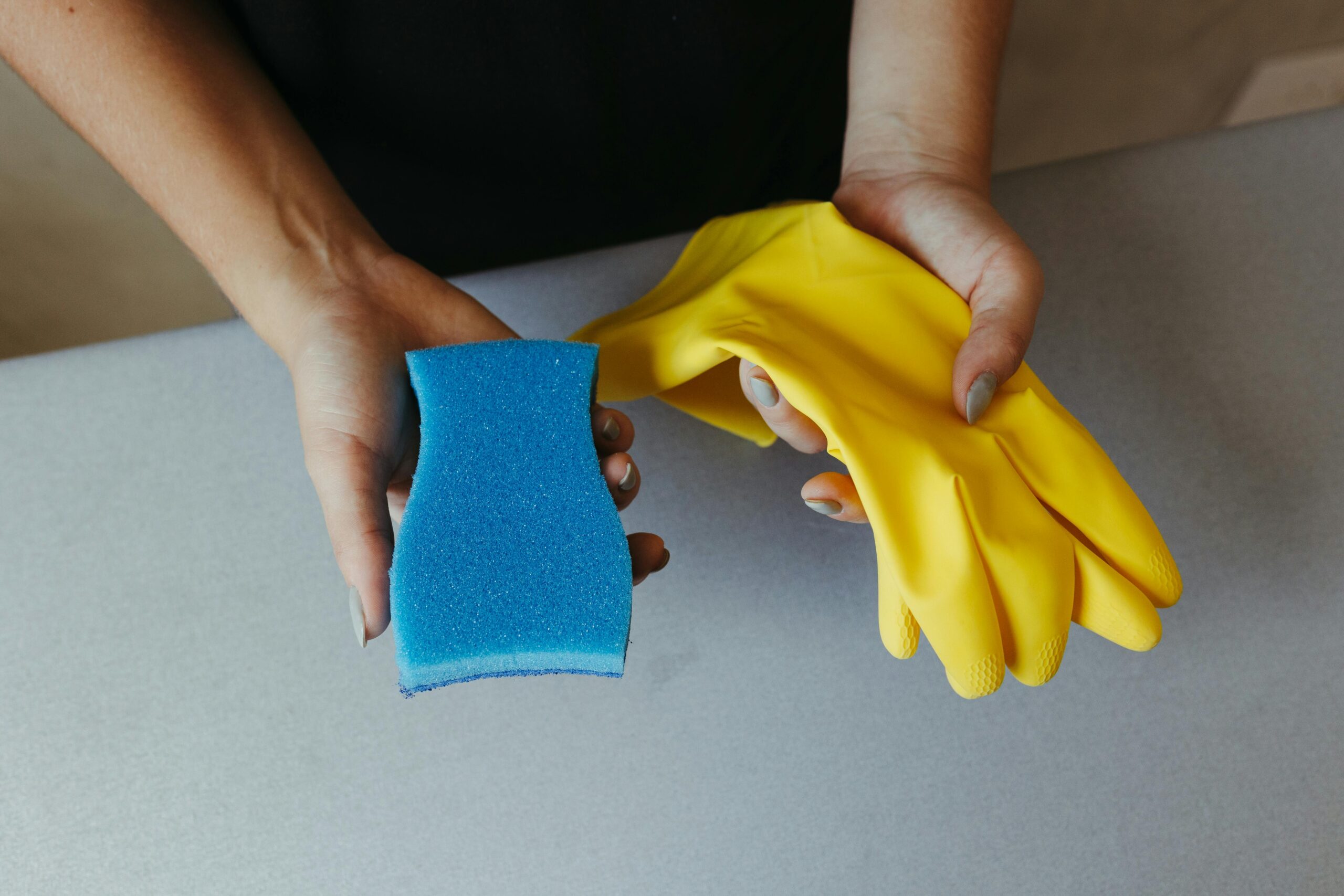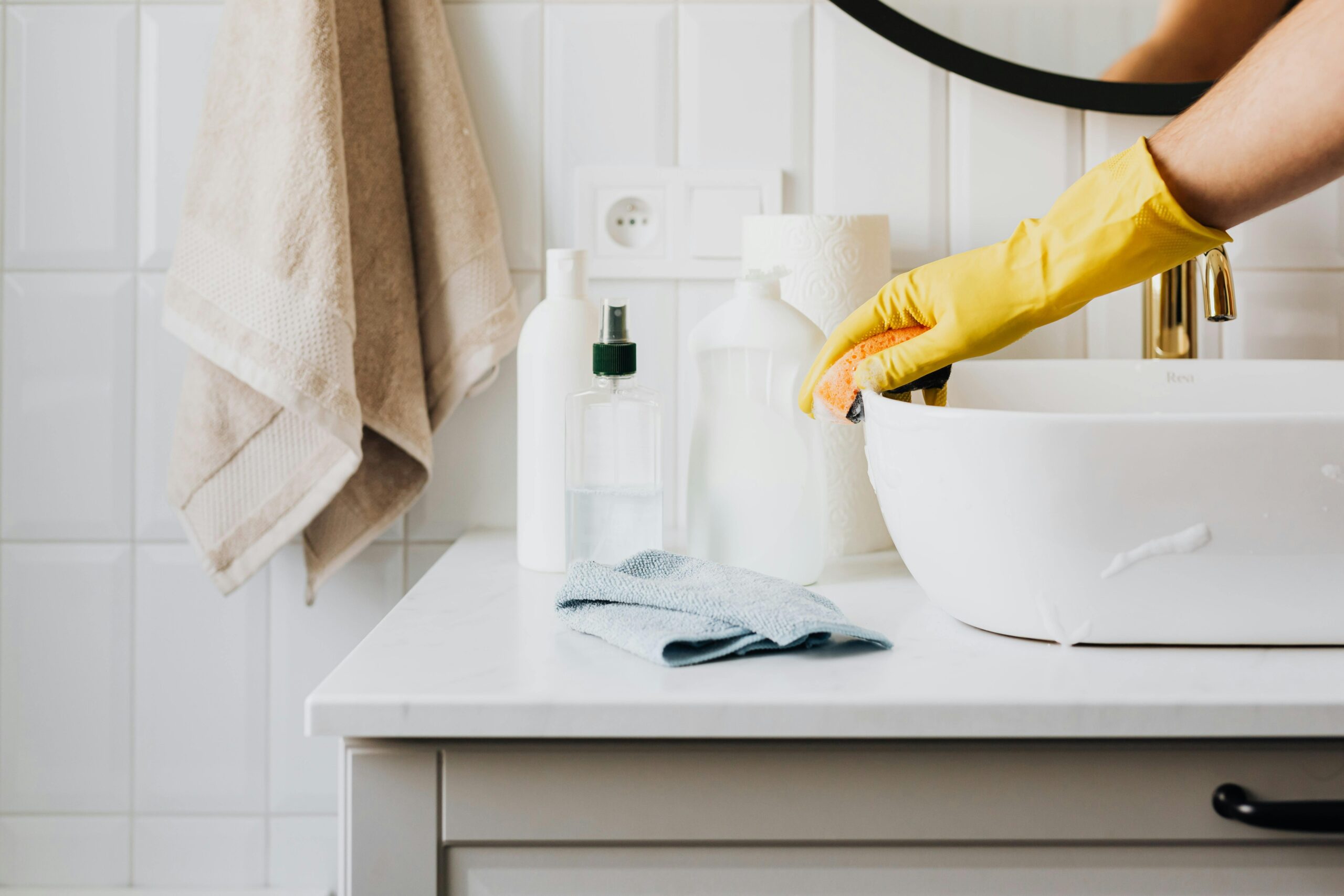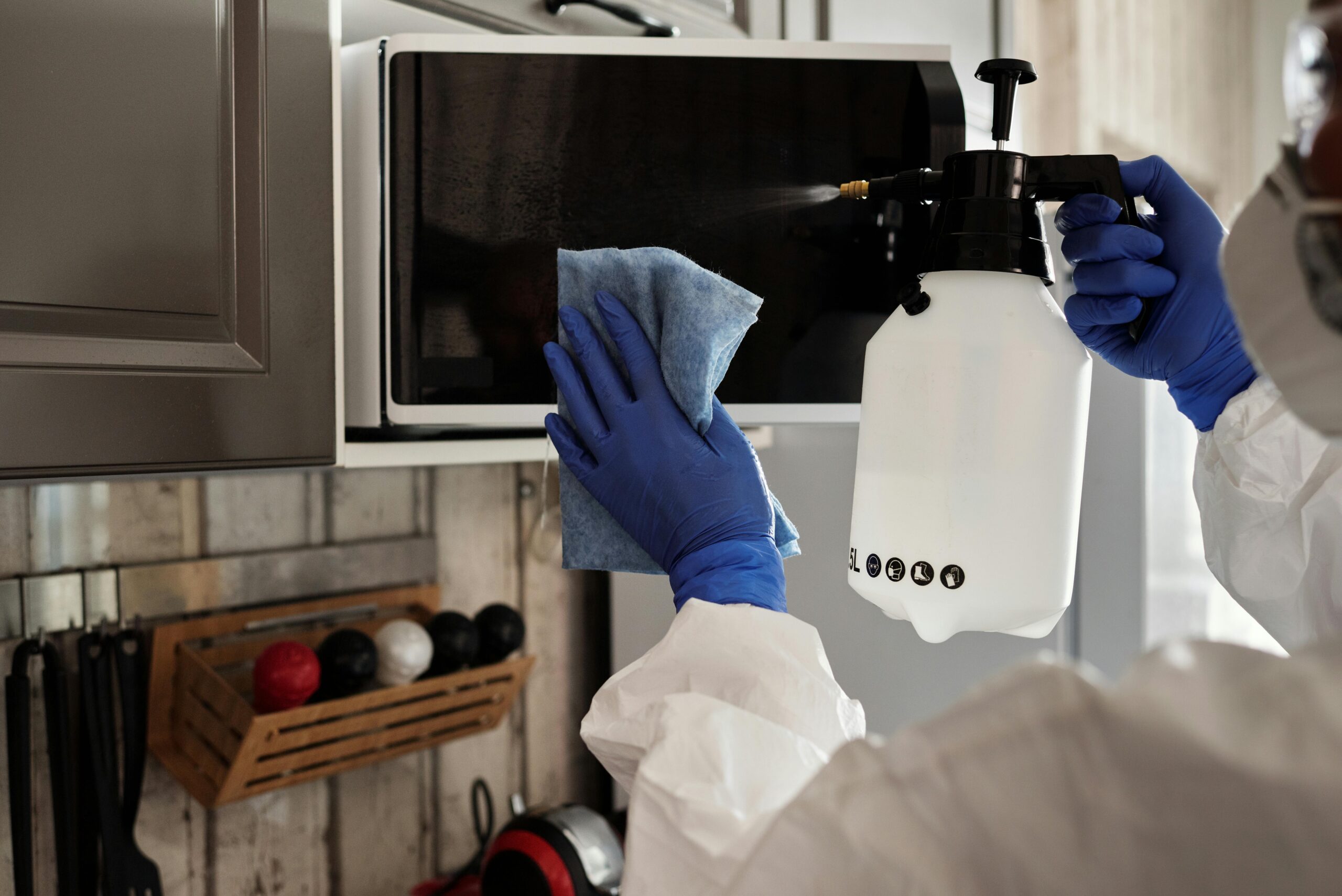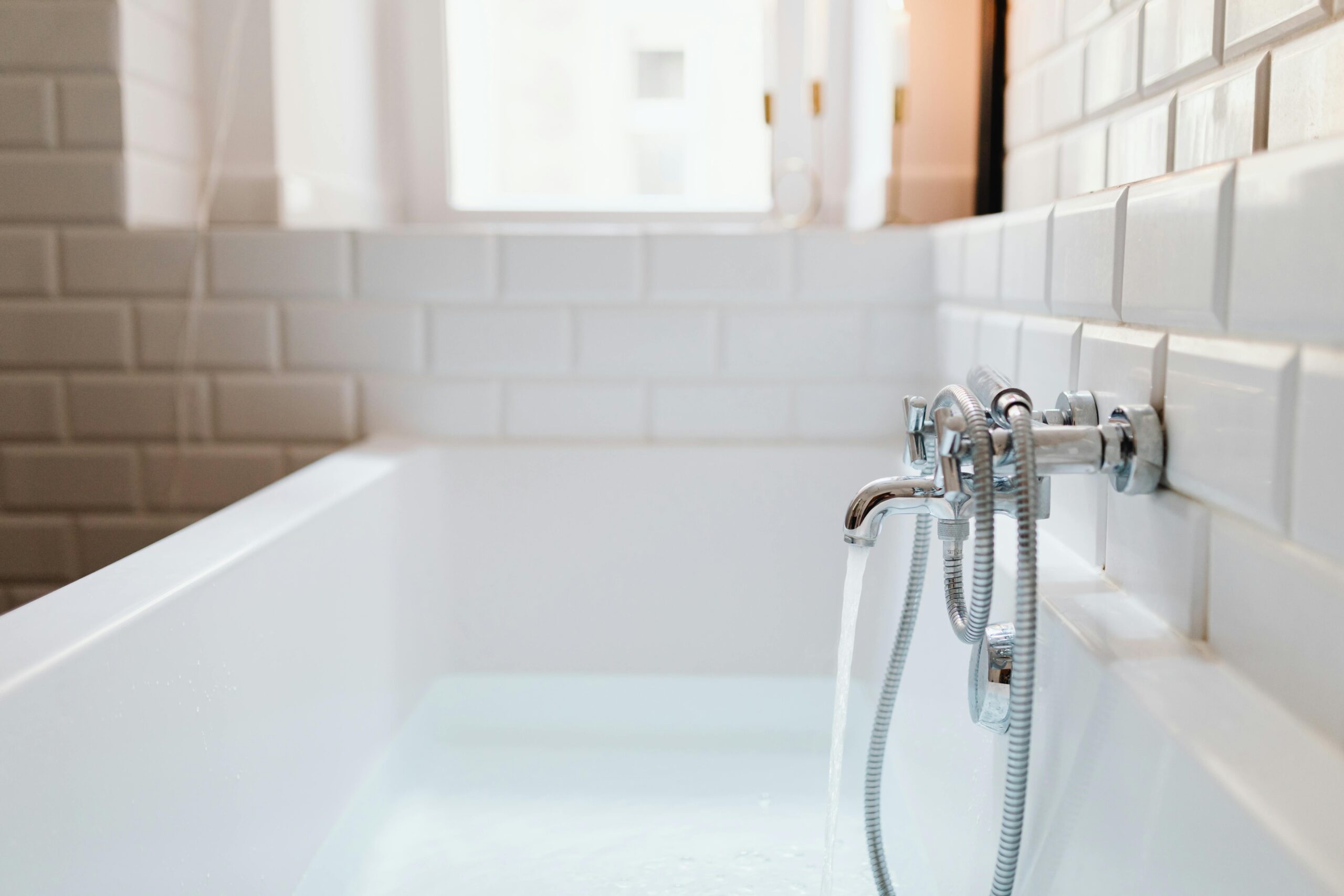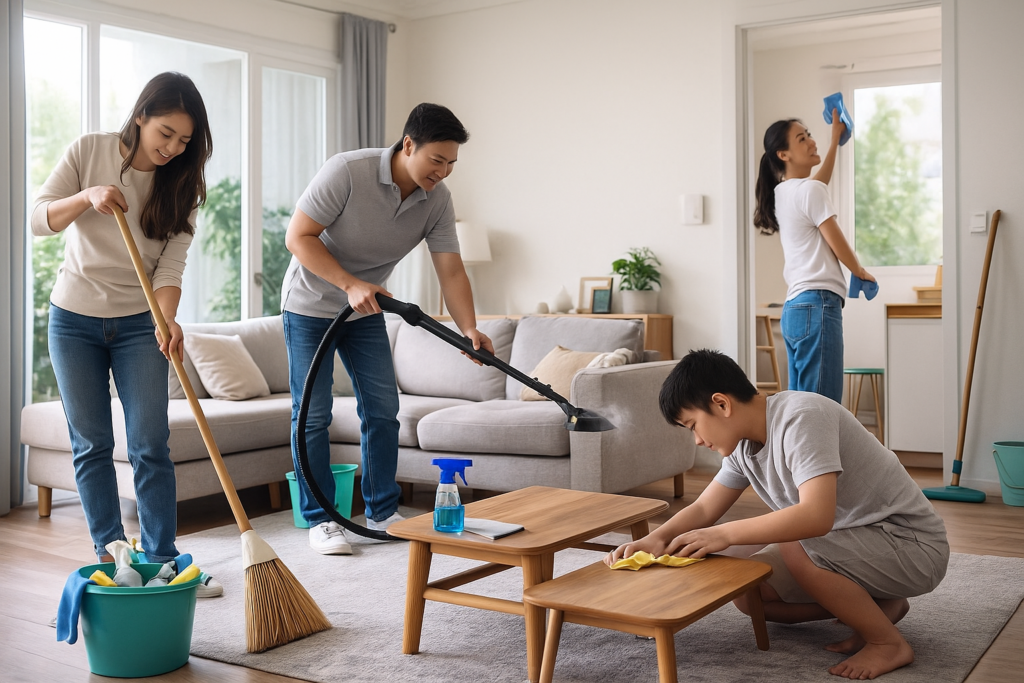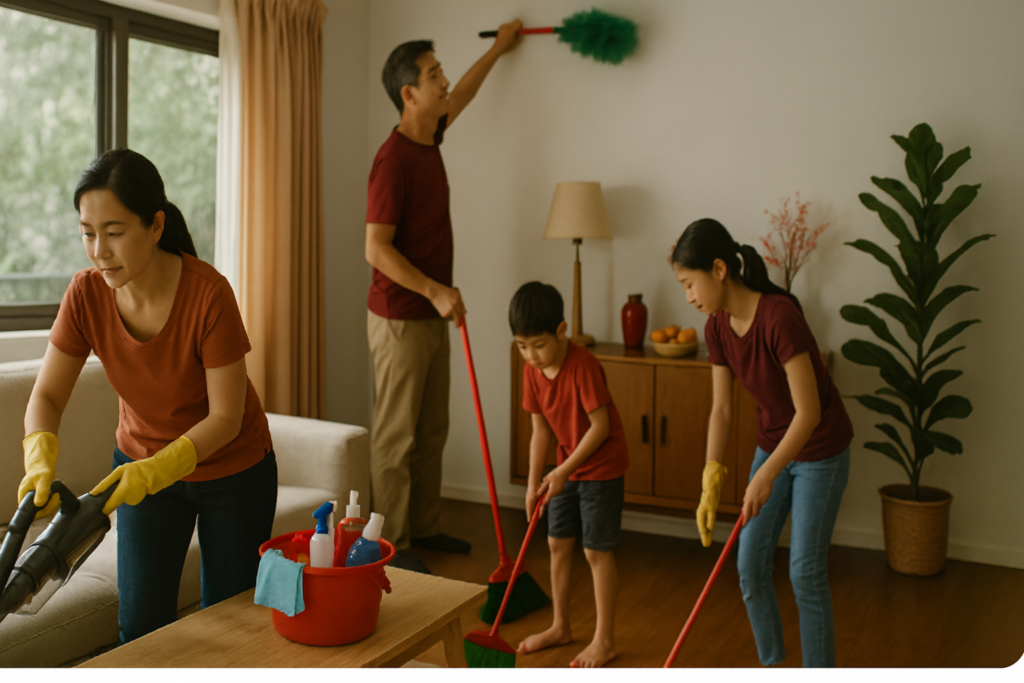Keeping your kitchen and bathroom clean is essential for a hygienic, safe and comfortable home environment. These areas are prone to bacteria buildup, moisture-related damage and stubborn grime, making regular cleaning necessary. However, cleaning a kitchen differs from bathroom cleaning due to the type of dirt and contaminants involved.
The kitchen accumulates grease, food particles and cooking fumes, while bathrooms are prone to soap scum, mineral deposits and mould. This guide covers the importance of maintaining these spaces and provides a step-by-step cleaning process to ensure a spotless, germ-free home.
Why Is Kitchen and Bathroom Cleaning Important?
Maintaining a clean kitchen and bathroom goes beyond appearances. It is crucial in maintaining hygiene, air quality and overall home maintenance. Without regular cleaning, these areas can become breeding grounds for bacteria, leading to potential health risks and unpleasant odours. Additionally, grease and mineral deposit buildup can cause long-term damage to surfaces, pipes and appliances.
Prevents Germs and Bacteria Growth
Kitchens and toilet rooms are high-moisture environments, making them ideal breeding grounds for bacteria, mould and mildew. In the kitchen, food particles and grease create the perfect environment for harmful bacteria to flourish. When neglected, it can lead to foodborne illnesses.
In toilet rooms, damp conditions encourage mould growth, which can cause respiratory issues. Regular maintenance with the right equipment and enlisting the help of professional cleaning services in Singapore help eliminate bacteria and prevent serious health risks.
Improves Air Quality and Reduces Odours
Mould and cooking fumes both contribute to poor indoor air quality and lingering odours. In the kitchen, grease buildup and food waste can cause unpleasant smells, while in toilet rooms, excess humidity leads to musty odours.
Using proper cleaning processes and ventilation techniques prevents the accumulation of odour-causing bacteria. A deep cleaning service can also help eliminate stubborn smells and restore freshness.
Extends the Lifespan of Surfaces and Appliances
Neglecting toilet and kitchen cleaning can lead to permanent dirt, corrosion and surface wear. Accumulated grease and soap scum degrade countertops, sinks and tiles, while mineral deposits damage bathroom fixtures and make them unsightly. Using the right kitchen cleaning equipment and hiring professional cleaners for deep cleaning ensures that appliances last longer and your surfaces are dirt-free.
Enhances Comfort and Aesthetic Appeal
A clean and organised kitchen and toilet room contribute to a more comfortable and inviting home. Clutter-free, fresh-smelling spaces have a positive psychological effect on you and make daily routines more enjoyable. Planning to sell your property later on? A well-maintained kitchen and bathroom improve home value, as potential buyers appreciate spaces that reflect good upkeep.
Essential Tools and Cleaning Products for Kitchen and Bathroom Cleaning
Keeping your kitchen and bathroom clean requires the right tools and cleaning agents to tackle grease, grime and stubborn stains. From disinfecting surfaces to preventing mould and bacteria buildup, having the proper supplies ensures a hygienic and fresh environment.
Must-Have Cleaning Tools
Using the right tools ensures efficient cleaning and helps tackle stubborn dirt in kitchens and toilets. It doesn’t matter if you’re hiring a cleaning service or opting for part-time cleaners now and then; you still need these essential tools to make the task more effective and maintain hygiene in your home.
- Microfiber cloths and sponges. Use these to wipe down countertops, sinks and kitchen appliances, as they trap dirt without scratching surfaces.
- Scrub brushes and scouring pads. These are necessary for scrubbing stubborn stains, especially in cleaning toilets, where soap scum and mineral deposits accumulate.
- Mops and floor brushes. These are essential for cleaning kitchen and toilet room flooring, effectively removing grime and bacteria from tiles and grout.
- Vacuum cleaner with attachments. Useful for regular, deep and move-out cleaning, ensuring that dust, debris, and allergens are completely removed from carpets, hard floors and even sofas.
- Rubber gloves. Gloves protect hands from harsh cleaning agents, preventing skin irritation when tackling dirt and bacteria.
- Squeegee. It helps keep mirrors, windows, shower doors and glass surfaces streak-free.
- Toilet brush and bowl cleaner. These are essential for maintaining a sanitised toilet and preventing bacteria buildup.
Recommended Cleaning Products
Using the right cleaning products is essential for effectively removing dirt, grease and smears from toilets, sinks, windows and other surfaces. Whether deep cleaning kitchen appliances or sanitising toilet room tiles, selecting the right products ensures a thorough cleaning while keeping your home safe.
Check out the list of recommended cleaning products below:
- Disinfectants and sanitisers. Alcohol-based, bleach-based and eco-friendly options help eliminate bacteria and germs from high-touch surfaces like sinks, countertops and toilets.
- Grease-cutting cleaners. Designed for stovetops, range hoods and kitchen appliances, these cleaners effectively break down grease and food residue.
- Mould and mildew removers. Essential for bathroom cleaning, these products prevent fungal growth on tiles, grout and shower walls.
- Glass cleaners. Formulated for mirrors, shower doors and windows, these cleaners help remove smudges and smears, leaving surfaces streak-free.
- Non-toxic cleaners. Safer alternatives for households with children and pets, these products get rid of dirt without harsh chemicals that may linger on meal preparation surfaces.
Safety Equipment
When handling strong cleaning products, proper safety gear is necessary to prevent skin irritation and exposure to fumes.
- Gloves (latex, nitrile, cloth). Protect hands when handling cleaning chemicals and scrubbing sinks, toilets and other surfaces. Cloth gloves are also helpful when dusting appliances and cleaning glass surfaces.
- Face mask. This personal protective equipment helps protect you from the odour of disinfectants, degreasers and washing solutions, particularly in enclosed areas like bathrooms.
Choosing the right cleaning agents and protective equipment ensures an efficient and safe cleaning process, giving you peace of mind while maintaining a hygienic home.
Step-by-Step Guide to Cleaning a Kitchen
This guide outlines the best cleaning techniques for tackling kitchen surfaces, furniture and appliances, ensuring a clean home that looks and smells fresh.
Step 1: Decluttering and Removing Expired Items
Before cleaning, start by decluttering and organising your kitchen. Remove expired food items from the fridge and pantry to prevent contamination and unwanted odours.
Wipe down shelves and storage areas, ensuring they remain free from spills and crumbs. Organise items in cabinets and on your countertops to create a tidy, functional space for meal preparation.
Step 2: Cleaning kitchen surfaces and appliances
Kitchen surfaces and appliances accumulate grease and bacteria over time, making regular cleaning required to maintain hygiene. Wipe down countertops, cabinets and backsplashes using a mild cleaner to remove stains and spills.
Pay special attention to stove tops, ovens and microwaves, scrubbing away baked-on grease. For stainless steel appliances, use a streak-free cleaner to restore their shine.
Step 3: Sink and Faucet Cleaning
The sink and tap are high-use areas prone to limescale buildup and water stains. Use a gentle descaling solution to remove hard water stains and polish fixtures.
To prevent clogs and foul odours, pour dishwashing liquid down the drain, followed by freshly boiled water. This method helps melt grease buildup, keeping the sink fresh and free from blockages.
Step 4: Cleaning kitchen floors
Kitchen flooring endures frequent spills and foot traffic, making daily cleaning essential. Vacuum or sweep thoroughly before mopping the floor to remove dust and crumbs. Choose the right floor cleaner based on the material – tile, laminate or hardwood – to avoid damage. A damp mop with a mild detergent effectively removes grease and stains.
Step 5: Rubbish disposal and odour control
Rubbish bins can quickly become a source of bad odours and bacteria if not cleaned regularly. Clean the bin with disinfectant and allow it to dry completely before use. To keep your home smelling fresh, place an odour-neutralising pouch of activated charcoal or citrus peel at the bottom of the bin. Opt for eco-friendly methods such as baking soda or activated charcoal to absorb unwanted smells.
Looking for regular professional cleaning services in Singapore? Book your kitchen and bathroom cleaning with Total Cleanz today!
Step-by-Step Guide to Cleaning a Bathroom
A clean bathroom is essential for hygiene and comfort, but maintaining it can be challenging, especially with stubborn stains, soap scum, and hidden grime. Regular cleaning helps prevent bacteria buildup, mould growth, and unpleasant odours, ensuring a fresh and inviting space.
However, deep cleaning requires time, effort, and the right cleaning agents. If you’re looking for a hassle-free way to keep your bathroom in top condition, consider hiring a cleaning professional like TotalCleanz Regular Cleaning Services for a thorough and efficient service.
Step 1: Removing Clutter and Organising
Start by removing unnecessary items from countertops, shelves and cabinets. Expired toiletries, empty bottles and unused products occupy space and contribute to clutter. Organising your bathroom essentials makes cleaning more efficient and ensures easy access to daily-use items.
Step 2: Cleaning Sinks, Faucets and Countertops
Sinks and faucets often develop limescale, water stains, and bacteria buildup due to constant exposure to moisture. Use appropriate cleaning agents like a mild descaler or a vinegar-based solution to remove stains and restore shine. Don’t forget to clean around the base of faucets and drain areas, as these spots often trap grime.
Step 3: Shower and Bathtub Cleaning
Soap scum and mould can accumulate on shower walls, bathtubs and glass doors. Scrubbing with the right cleaning agents can help break down residue, leaving surfaces spotless. For stubborn stains, consider professional cleaning services to ensure a deep and thorough clean. A professionally trained cleaner can tackle tough grime while protecting bathroom surfaces.
Step 4: Toilet Cleaning and Disinfection
Toilets require regular cleaning to prevent bacteria buildup and stains. Use a strong disinfectant to clean the bowl, seat and flush handle. Pay special attention to areas under the rim where germs often accumulate. If you’re short on time, part-time cleaners can provide reliable assistance to maintain cleanliness.
Step 5: Floor and Drain Cleaning
Bathroom floors and drains collect hair, dust and soap residue, leading to blockages and odours. Sweep or vacuum the floor before mopping with a suitable cleaner. To prevent clogging, pour hot water mixed with dishwashing liquid down the drain regularly. If drainage issues persist, cleaning professionals can help with specialised solutions.
Get Reliable Cleaning Services at Your Preferred Date
Keeping your bathroom in pristine condition doesn’t have to be a struggle. Whether you need a one-time deep clean or regular maintenance, part-time cleaners can offer flexible scheduling to suit your needs. Choose a preferred date for your cleaning session and enjoy a hygienic, refreshed bathroom without the hassle.
Total Cleanz provides excellent service with experienced, professionally trained staff to handle all your cleaning needs. From tackling stubborn stains to ensuring every corner is spotless, their team delivers good service that leaves your home fresh and clean.
Book your cleaning today and experience the convenience of a professionally maintained bathroom!
How to Handle Common Kitchen and Bathroom Cleaning Challenges
Kitchens and bathrooms are among the most used areas in any house, making them prone to dirt, grease and stubborn stains. Food spills on countertops, soap scum on bathroom tiles and grease buildup on the stove and oven can be challenging to remove without the right cleaning techniques.
Regular maintenance helps, but some messes require a thorough cleaning to restore surfaces to their original condition. Whether tackling everyday spills or tough grime, knowing the best solutions will save you time and effort.
How to Remove Stubborn Stains on Kitchen Counters and Bathroom Tiles
Stains from food, spills and mineral deposits can make your kitchen and toilet surfaces look dull and unclean. However, using the right cleaning solution helps break down these stains without damaging countertops or bathroom tiles.
- Food stains on kitchen counters. Use baking soda and water paste. Apply, let it sit for a few minutes, then wipe clean. For stubborn stains, a vinegar solution works well, too.
- Soap scum on bathroom tiles. Mix white vinegar and dishwashing liquid in equal parts, apply to the tiles, let it sit for a few minutes and scrub with a sponge or brush. A thorough cleaning session can also help remove built-up grime.
- Mineral deposits on sinks and taps. Use baking soda and water paste to dissolve limescale and restore shine to taps.
How to Get Rid of Grease and Grime in the Kitchen
Cooking leads to grease buildup on the stove, oven and exhaust fan. Removing grease regularly prevents it from hardening and becoming more difficult to clean.
- Best degreasers for stovetops and exhaust fans. Commercial degreasers effectively cut through tough grease. Look for a product designed for kitchen appliances to ensure safety and effectiveness.
- Natural DIY grease removers. Mix vinegar and water in a spray bottle and apply to greasy surfaces. Another option is baking soda and warm water, which works well on stoves and kitchen backsplashes.
How to Prevent Mould and Mildew Growth in Bathrooms
Mould and mildew thrive in damp environments, making bathrooms one of the most vulnerable areas in any home. Excess moisture from hot showers, poor airflow and unclean toilets can contribute to fungal growth, leading to unpleasant odours and potential health risks. Preventing mould requires proper ventilation and moisture control, along with regular use of anti-mould treatments.
- Proper ventilation and moisture control. Ensure your bathroom has adequate airflow by keeping windows open or using an exhaust fan. Wipe down wet surfaces, such as toilets, shower doors and tiles, to reduce humidity buildup.
- Best anti-mould sprays for long-term prevention. Choose anti-mould sprays with hydrogen peroxide or tea tree oil to inhibit regrowth. For exterior areas exposed to moisture, a specialised mould-resistant sealant can be applied to tiles and grout.
If mould buildup becomes severe, consider requesting professional cleaning services for a deep cleaning session.
How to Keep Your Kitchen and Bathroom Smelling Fresh
Persistent odours in kitchens and bathrooms can result from clogged drains, overflowing trash bins or stagnant water in sinks and toilets. Regular cleaning and using natural deodorisers can help keep these spaces fresh.
- Eliminate odours by cleaning your kitchen and bathroom daily. Don’t let rubbish pile up, and make sure these rooms are properly ventilated.
- Use essential oil diffusers or air-purifying plants to maintain a pleasant scent. Avoid artificial sprays with strong chemicals, as they can mask rather than eliminate odours.
How Often Should You Clean?
| Cleaning Task | Kitchen | Bathroom |
|---|---|---|
| Daily | Wipe countertops, wash dishes, take out rubbish | Clean sink, wipe toilet seat, ventilate area, take out rubbish |
| Weekly | Clean appliances, mop floors, sanitise sink | Scrub toilet bowl, deep clean shower/tub, mop floors |
| Monthly | Deep clean oven, defrost freezer, clean cabinets | Scrub grout, descale showerhead, clean exhaust fan |
When to Hire Professional Kitchen and Bathroom Cleaning Services
Maintaining a clean kitchen and toilet room is essential for hygiene and comfort. While some cleaning tasks are manageable on your own, there are situations where hiring professionals is the best choice.
When to Opt for DIY Cleaning
DIY cleaning is ideal for:
- Routine maintenance, such as wiping counters, scrubbing sinks and sweeping floors.
- Tackling small tasks, such as removing minor stains and deodorising drains.
- Property owners who want flexibility as this allows you to clean on your schedule without relying on external help.
When to Opt for Professional Cleaning
Hiring a professional cleaning service is beneficial when:
- Deep cleaning is required for hard-to-reach areas like tile grout, vent hoods and behind appliances.
- Mould removal is needed to prevent regrowth in bathrooms and kitchens with high humidity.
- Limescale buildup is difficult to remove from taps, shower doors and sinks.
- Post-renovation cleanup requires specialised equipment to remove dust, debris and construction residue.
- Time-saving and thorough results are a priority, especially for busy households or businesses.
For regular professional cleaning services, including kitchen and bathroom cleanup, visit Total Cleanz.
Cost Comparison
| Cleaning Method | Estimated Cost |
|---|---|
| DIY cleaning (supplies like all-purpose cleaners, degreasers, scrub brushes) | $20 to $50 per month* |
| Professional kitchen cleaning (deep cleaning of appliances, cabinets and floors) | $250 to $400 per session |
| Professional toilet cleaning (mould removal, tile scrubbing, drain cleaning) | $80 to $200 per session |
| Full kitchen and bathroom deep clean | $200 to $500 per session |
*depends on how often you conduct cleaning and the size of your property.
Prices vary from one cleaning service company to another. Moreover, some companies charge per square foot or hour, so check with your provider for an accurate quote.
Conclusion
Keeping your kitchen and bathroom clean is essential for a healthy and comfortable home. Using the right cleaning solutions helps remove smears, grease, and grime. Preventing mould and mildew through proper ventilation and moisture control ensures a fresh environment. Regular odour-neutralising techniques keep your space smelling clean while a consistent cleaning schedule prevents dirt and buildup.
Whether you handle cleaning yourself or hire professionals for deep cleaning, maintaining a tidy home contributes to a healthier lifestyle.
For professional cleaning services, visit Total Cleanz. A clean kitchen and bathroom start with regular care, so begin that journey today!

